ANDONG FULL-DAY TOUR
-
- Price
- 200,000 KRW / Person
- Minimun Pax
- 4 People
- Time
- Daily 08:00am ~ 19:00pm
- Inclusion
- Transportation, English-speaking Tour Guide-cum-Driver, Admission Fees, Lunch, Hotel Pick-up/Drop-off Services, VAT.
- Exclusion
- Dinner, Personal Expenses.
Tour Course
-
- Hotel (Seoul)
- Move to Andong (3.5hours)
- Buyongdae Cliff
- Hwacheon Seowon
- Lunch (Bibimbap)
- Hahoe Village
- Hahoe MasK Museum
- Move to Seoul (3.5hours)
- Hotel.
Highlights
-
-
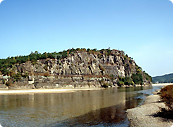
-
- Buyongdae Cliff
-
Buyongdae is a cliff about 64 meters high situated where the Taebaek Mountain Range ends. From the summit, one can get a bird's eye view of the Hahoe Village in Andong.
The name was taken from an ancient history of China. Meaning lotus, the name Buyongdae is said to be given for Hahoe Village's configuration like a lotus flower. Thus, one can get the best view of the village from the cliff.
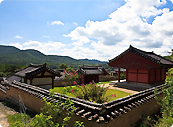
-
- Hwacheon Seowon
-
Located across from Andong Hahoe Village, this hanok was built in 1786 (10 years into the reign of King Jeongjo from the Joseon Dynasty) to hold the tablet of Ryu Un-ryong, the brother of Ryu Seong-ryong who is a renowned scholar and official from the Joseon Dynasty.
The Confucian memorial hall was closed in 1868 (5 years into the reign of King Gojong from the Joseon Dynasty), when Confucian academies were overhauled across the country. It was then used as a private school for some 100 years. In 1996, the buildings were restored, including a shrine, a gate tower, east and west residences, and a kitchen where food for memorial services is prepared.
The lecture hall, named Sunggyodang, sits on a stone platform, and has a wooden-floored hall. The hall is fitted with six front windows that can be lifted up and fixed onto the rafters, rendering the hall more spacious. Behind the shrine named Gyeongdeoksa is a trail, where one can take a 10-minute stroll to reach the Buyongdae Cliff, which overlooks Hahoe Village.
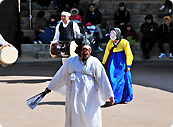
-
- Hahoe Village
-
Hahoe Village is home to descendants of the Ryu clan of Pungsan and is well-known for its traditional houses. Birthplace of renowned scholars of the Joseon Period such as Gyeomam Ryu Un-ryong and Seoae Ryu Seong-ryong, the village became even more famous after Queen Elizabeth of England visited on April 21, 1999.
Hahoe Village (translating to "Village Enveloped by Water") gets its name from Nakdong River, which flows around the town's perimeter. The village is located at the foothills of Hwasan Mountain, an offshoot of Taebaek Mountain that rises up to the east. The center of the village is populated by large tile-roofed houses belonging to the Ryu clan, adding their own unique charm to the surrounding thatched roofs.
Hahoe Village boasts exquisite scenic sights: the elegant Nakdong River flowing around the village, the magnificent Buyongdae Cliff, endlessly unfolding sandy beaches, and lush, ancient pine trees.
Hahoe Village, along with Yangdong Village in Gyeongju, was added to the UNESCO World Heritage List under the category of "Historic Villages in Korea" on July 31, 2010.
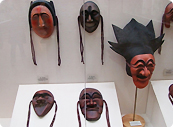
-
- Hahoe Mask Museum
-
Hahoe Mask Museum is located in Andong Hahoe Village, which is both a UNESCO World Heritage Site and Important Folklore Material No. 122.
Hahoe Village is a representative traditional Korean folk town and is the home of the Hahoe Mask (National Treasure No. 121) and the Byeolsin Gut Mask Dance (Important Intangible Cultural Properties No. 69). The museum not only displays Hahoe masks, but also other traditional masks from all over the world.
At the museum, you'll encounter time-honored Korean masks that have long since been used in a variety of traditional mask dances. Masks include Bongsan, Gangnyeong, and Eunnyul masks from Hwanghae-do province; Sandaenori masks (Yeongju Byeolsandae and Songpa Sandaenori) from Seoul; Yaryu(Dongrae Yaryu, and Suy-eong Yaryu masks) and Ogwangdae (Goseong Ogwangdae, Gasan Ogwangdae, Tongyeong Ogwangdae masks) from the Yeongnam region; Hahoe masks from Andong; Yeonghae Byeolsin Gut masks; Yeonggwang Nongakjapsaek masks; Yecheon Cheongdan Noreum masks; the Gangneung Gwanno Mask of the Gangneung Dano Festival; the Deotboegi mask of Namsadang nori; and Cheoyong, Bangsangssi ceremonial masks.
-


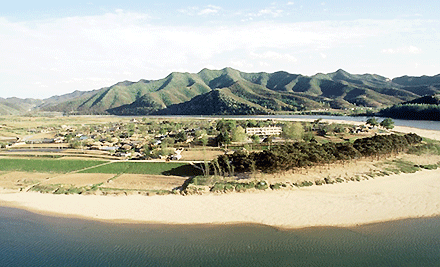

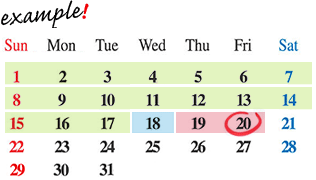

 E-mail
E-mail


























